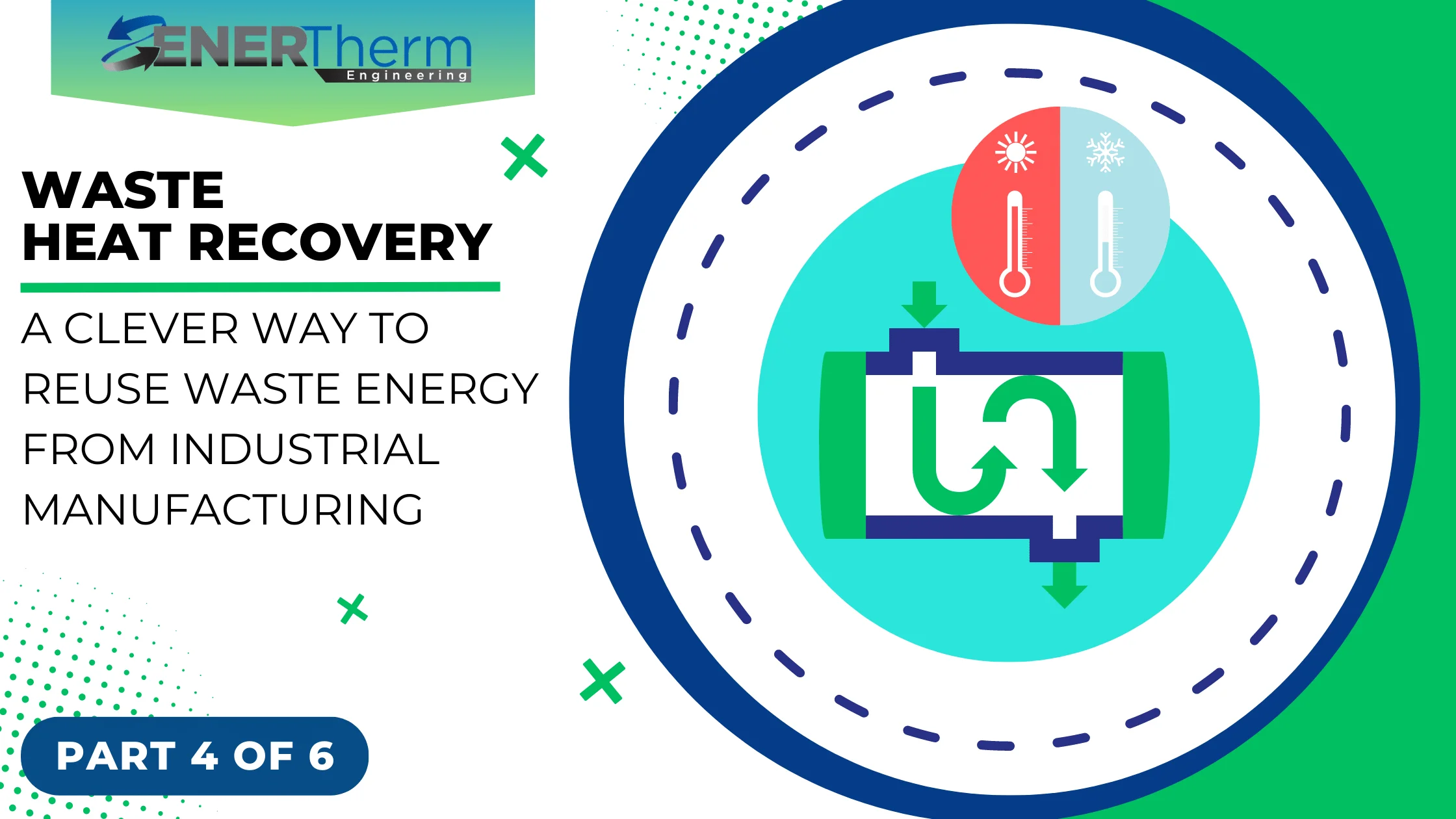What is waste heat recovery and what is it used for in industrial manufacturing?
Waste heat recovery is a process that captures waste heat from industrial processes or power generation. It either reuses it within the same system or transfers it to another system for heating or cooling purposes.
Waste heat recovery can be used for various purposes in industrial manufacturing, such as:
- Improving energy efficiency, by reducing the energy consumption and emissions of industrial processes or power plants, by reusing the waste heat for preheating, drying, or cogeneration.
- Saving costs, by lowering the fuel and electricity bills of industrial processes or power plants, by reusing the waste heat for heating, cooling, or refrigeration.
- Reducing emissions, by avoiding the use of fossil fuels or electricity for heating or cooling purposes, by reusing the waste heat for district heating, absorption cooling, or heat pumps.
How efficient is waste heat recovery for industrial manufacturing?
The efficiency of waste heat recovery for industrial manufacturing depends on various factors, such as the type of waste heat source (low, medium, or high temperature), the type of waste heat recovery technology (economisers, condensers, organic Rankine cycles, absorption chillers, etc.), and the heat recovery ratio.
- The type of waste heat source refers to the temperature level of the waste heat stream that is generated by an industrial process or a power plant. The main types of waste heat sources are:
- Low temperature (<100°C), which is typically produced by cooling systems, ventilation systems, or washing systems. Low temperature waste heat can be recovered using heat exchangers, heat pumps, or absorption chillers.
- Medium temperature (100°C-400°C), which is typically produced by combustion processes, drying processes, or chemical reactions. Medium temperature waste heat can be recovered using economisers, condensers, or organic Rankine cycles.
- High temperature (>400°C), which is typically produced by melting processes, calcination processes, or gasification processes. High temperature waste heat can be recovered using steam Rankine cycles, gas turbines, or thermoelectric generators.
- The type of waste heat recovery technology refers to the method of capturing and transferring waste heat from one system to another. The main types of waste heat recovery technologies are:
- Economisers are heat exchangers that preheat the feed water or the combustion air of a boiler or a furnace, using the waste heat from the flue gas.
- Condensers are heat exchangers that condense the water vapour from the flue gas of a boiler or a furnace, using the waste heat to preheat the feed water or to provide hot water for other uses.
- Organic Rankine cycles, are thermodynamic cycles that use an organic fluid (such as pentane or ammonia) instead of water as the working fluid, to convert medium temperature waste heat into mechanical power or electricity.
- Absorption chillers are cooling systems that use a refrigerant (such as water) and an absorbent (such as lithium bromide) to produce chilled water or air, using low temperature waste heat as the driving force.
- Heat pumps are devices that use refrigerant and electricity to transfer heat from a low-temperature source (such as outdoor air or ground) to a high-temperature sink (such as a building or a process), even in colder temperatures. Heat pumps can also work in reverse, providing cooling or dehumidification by transferring heat from a high-temperature source to a low-temperature sink.
- The heat recovery ratio refers to the percentage of waste heat that is recovered and reused by a waste heat recovery system. The heat recovery ratio depends on various factors, such as the temperature difference between the source and the sink, the type and design of the waste heat recovery technology, and the operational conditions. The typical heat recovery ratio for waste heat recovery systems ranges from 10% to 90%.
What are the pros and cons of waste heat recovery for industrial manufacturing?
Waste heat recovery has several advantages for industrial manufacturing, such as:
- Enhancing energy performance, by reducing the energy consumption and emissions of industrial processes or power plants, by reusing the waste heat for preheating, drying, or cogeneration.
- Lowering fuel consumption, by reducing the fuel demand and costs of industrial processes or power plants, by reusing the waste heat for heating, cooling, or refrigeration.
- Increasing competitiveness, by improving the productivity and profitability of industrial processes or power plants, by reusing the waste heat for district heating, absorption cooling, or heat pumps.
However, waste heat recovery also has some disadvantages for industrial manufacturing, such as:
- High upfront investment, which makes waste heat recovery projects less attractive and feasible than other energy efficiency options, especially for small and medium-sized enterprises.
- Technical complexity, poses challenges for the integration and operation of waste heat recovery systems, especially for large-scale and multi-source systems.
- Operational challenges, which require careful monitoring and control of waste heat recovery systems, to ensure optimal performance and reliability.
- Market barriers create obstacles to the development and deployment of waste heat recovery projects, such as a lack of awareness, information, and incentives among industrial users and stakeholders.
How much can waste heat recovery contribute to net zero and decarbonisation goals for industrial manufacturing?
Waste heat recovery can contribute significantly to net zero and decarbonisation goals for industrial manufacturing, by reducing the energy consumption and emissions from heating and cooling systems. According to the International Energy Agency (IEA), waste heat recovery could cut global CO2 emissions from industrial manufacturing by 1.2 gigatons per year by 2050, compared to a business-as-usual scenario. This would represent a 12% reduction in industrial emissions and a 3% reduction in global emissions.
The potential contribution of waste heat recovery to net zero and decarbonisation goals for industrial manufacturing depends on various factors, such as the availability and quality of waste heat sources, the development and deployment of waste heat recovery technologies, the adoption and diffusion of waste heat recovery systems, and the policy support and incentives for waste heat recovery projects.
According to the IEA, waste heat recovery could constitute approximately 10% of cumulative CO2 emissions reductions in the industry by 2050, compared to a business-as-usual scenario. This would require a rapid increase in the deployment of waste heat recovery systems, from 100 megatons per year in 2020 to 500 megatons per year in 2030, and to 1,200 megatons per year in 2050. This would also require a significant increase in the installed capacity of waste heat recovery, from 100 megawatts in 2020 to 500 megawatts in 2030, and to 1,200 megawatts in 2050.
Is waste heat recovery future proof for industrial manufacturing?
Waste heat recovery is likely to be future proof for industrial manufacturing, as it can provide a low-cost and effective solution for improving energy efficiency and reducing emissions from heating and cooling systems. However, there are some challenges and uncertainties that need to be addressed, such as:
- Technological developments are needed to improve the efficiency, performance, reliability, and durability of waste heat recovery technologies, as well as to reduce their costs, maintenance, and environmental impacts.
- Policy support, which is needed to create a favourable regulatory framework, provide financial incentives, remove market barriers, and raise awareness and confidence among industrial users and stakeholders.
- Consumer demand, which is needed to stimulate the uptake and diffusion of waste heat recovery systems, as well as to ensure their proper operation and maintenance.
- Integration with other systems, which is needed to ensure the compatibility and synergy of waste heat recovery systems with other energy efficiency or low-carbon technologies, such as heat pumps, CHP, or CCUS.
To ensure that waste heat recovery is future proof for industrial manufacturing, it is essential to foster collaboration and coordination among different actors, such as policy makers, industry associations, manufacturers, suppliers, researchers, and end-users. It is also important to monitor and evaluate the performance and impacts of waste heat recovery systems and to share best practices and lessons learned. By doing so, waste heat recovery can play a key role in achieving net zero and decarbonisation goals for industrial manufacturing.
Take Action for a Sustainable Future with Enertherm Engineering
Are you ready to take the next step towards a more sustainable and efficient future for your industry? Enertherm Engineering is here to help you harness the power of waste heat recovery. Our innovative solutions are designed to turn waste energy into a valuable resource, reducing your carbon footprint and boosting your bottom line.
Don’t let your waste energy go to waste. Contact us today to learn more about how our waste heat recovery systems can benefit your business. Together, we can create a greener, more efficient world.

